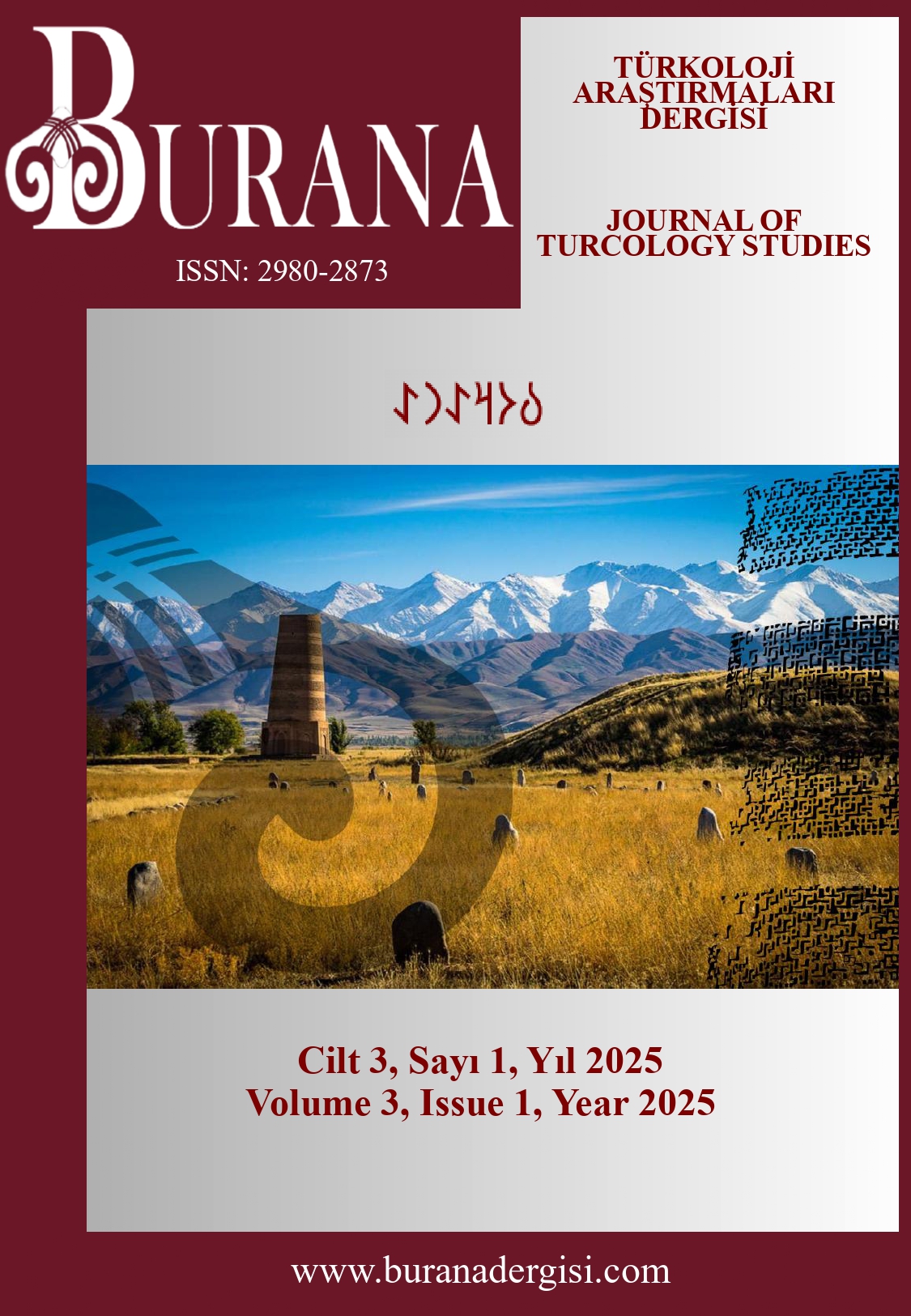The Occurrence of Archaic Words in Contemporary Kyrgyz Turkish in Mahmud al-Kashgari’s Dīwān Lughāt al-Turk
DOI:
https://doi.org/10.5281/zenodo.15769011Keywords:
Dīwān Lughāt al-Turk, Active Vocabulary, Archaic Words, Lexical Meanings, Kyrgyz TurkishAbstract
Since social phenomena are constantly changing and evolving, the vocabulary of a language also undergoes transformation. In order to meet the need for mutual communication among individuals, vocabulary continually expands with new words or synonyms. The obsolescence and eventual disuse of certain words and meanings is recognized as a complex process that unfolds over a long period of linguistic development.
For instance, some archaic words in contemporary Kyrgyz Turkish are found both in Mahmud al-Kashgari’s Dīwān Lughāt al-Turk and in the variant of the Manas epic compiled by Sagımbay Orozbakov. Although some of these words are no longer part of the active vocabulary of modern Kyrgyz Turkish, they continue to live on in the collective memory of the people and are still used in folk literature, geographical place names, literary texts, and other written or oral sources. The language of the Manas epic, with its rich vocabulary and particularly striking artistic expressions, is regarded as a standard model of the Kyrgyz vernacular. Researchers have stated that there is approximately an 80% lexical similarity between modern Kyrgyz Turkish and the language of Dīwān Lughāt al-Turk. Of course, this similarity represents only one aspect of the connection between the two linguistic stages. Another important point is that Kyrgyz Turkish of the last century was even closer to the language of the aforementioned dictionary. This is evidenced by the numerous archaic words that appear both in the Manas epic and in the dictionary compiled by H. Karasaev, and that also exist in Mahmud al-Kashgari’s work. Thus, the deeper one traces back the layers of Kyrgyz Turkish, the closer it appears to the language of Dīwān Lughāt al-Turk. The aim of this article is to compare archaic words in contemporary Kyrgyz Turkish with those found in Dīwān Lughāt al-Turk. During the research process, lexical, morphological, and semantic comparative methods were employed. As a result, it was determined that many archaic words in Kyrgyz Turkish appear in Mahmud al-Kashgari’s work with similar meanings. The findings obtained from this study may be utilized in educational settings and scholarly publications. Moreover, the ideas presented in this article are proposed to the academic community for further consideration.
References
Ahmatov, T. (2011). Kaşkarlık Mahmuddun “Divan lugat-it türk” – türk tildelerinin sözdügü” – cana kırgız tili [Sözlü sunum]. Kaşgarlı Mahmud ve Kırgız Kültürü Sempozyumu, Bişkek, Kırgızistan.
İsaev, O. (1977). Jer-suu attarının sırı. Mektep.
Karasaev, H. (2016). Kamus naama. Salam.
Manas: Kırgız elinin baatırdık eposu (1995). Sagımbay Orozbakovdun varyantı boyunça akademiyalık basılış. I-kitep. Kırgızstan.
Manas: Kırgız elinin baatırdık eposu (1995). Sagımbay Orozbakovdun varyantı boyunça akademiyalık basılış. II-kitep. Kırgızstan.
Manas: Kırgız elinin baatırdık eposu (1995). Sagımbay Orozbakovdun varyantı boyunça akademiyalık basılış. III-kitep. Kırgızstan.
Manas: Kırgız elinin baatırdık eposu (1997). Sagımbay Orozbakovdun varyantı boyunça akademiyalık basılış. IV-kitep. Kırgızstan.
Manas: Kırgız elinin baatırdık eposu (2006). Sagımbay Orozbakovdun varyantı boyunça akademiyalık basılış. V-kitep. Kırgızstan.
Manas: Kırgız elinin baatırdık eposu (2006). Sagımbay Orozbakovdun varyantı boyunça akademiyalık basılış. VI-kitep. Kırgızstan.
Manas: Kırgız elinin baatırdık eposu (2014). Sagımbay Orozbakovdun varyantı boyunça akademiyalık basılış. VIII-IX-kitep. Kırgızstan.
Mahmud Kaşgari. (2011). Türk tilderinin sözdügü – Divanu lugati-t-türk. (T. Tokoev, K. Koşmokov Çev.). Avrasyapress.
Mahmud Kaşgari. (2016). Divanu lugati-t-türk - türk tilder söz cıynagı. (İ. Abdüvaliev, T. Ahmatov, A. Omorov Çev.). Turar.
Mamıtov, C. (2002). Eskirgen sözdör menen dialektizmlerdin lingvostilistikası. Uçkun.
Seydakmatov, K. (1988). Kırgız tilinin kıskaca etimologiyalık sözdügü. İlim.
Sultanaliev, İ. Ş. (2015). Mahmud Kaşgarinin “Divanu lugati-t türkünün tili”. Uçkun.
Yudahin, K. K. (1965). Kirgizsko-russkiy slovar. Sovetskaya Entsiklopediya.
Yudahin, K. K. (2000). Russko-kirgizskiy slovar. Şam.
Yürümez, R. (2022). Çağatay şairi Harabati’nin Fakr-Namesi. Paradigma.
Cakıpbek, A. (1995). Teniri Manas. Kyrgyzstan.
Cusupov, K. (1995). Manas. Dla detey.
Kasımbekov, T. (1990). Sıngan kılıç. Mektep.
Downloads
Published
How to Cite
Issue
Section
License
Copyright (c) 2025 BURANA - Journal of Turcology Studies

This work is licensed under a Creative Commons Attribution 4.0 International License.


